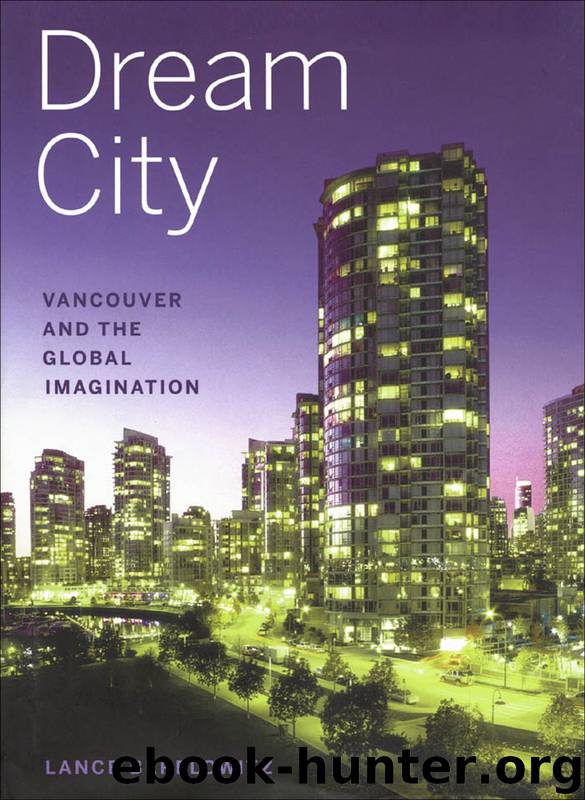Dream City by Lance Berelowitz

Author:Lance Berelowitz [Berelowitz, Lance]
Language: eng
Format: epub
Tags: ARC000000
Publisher: D & M Publishers
Published: 2005-04-10T04:00:00+00:00
Eugenia Place condominium tower, by Henriquez & Partners, completed in 1991. Lance Berelowitz photo
This is not to say all urban housing must be tall. On the contrary, some of Vancouver s most successful inner-city housing was built on the Fairview Slopes leading down to False Creek, at net densities not much lower than the Sylvia tower. Peter Cardew’s crisply calibrated row of narrow attached townhouses at 682-698 Millbank Street (1975) along the False Creek South waterfront, for example, was a prototypical contemporary interpretation of that old workhorse of urban housing, the row house. Sadly, this exquisite little project has seldom been emulated since, and never bested. Row housing remains an endangered species in Vancouver.
Roger Hughes and Nigel Baldwin’s Governor Generals Award-winning Sixth Estate (1982) residential project, to choose another example farther up the hill in Fairview Slopes, with its continuous “city wall” to busy 6th Avenue, forms a bulwark to the many other housing projects that threaten to tumble down the slope behind it. In the Sixth Estate, a clear hierarchy of streets was created: 6th Avenue, the primary vehicular route; a pedestrian route, the internal street through the scheme that separates the retained commercial buildings on 6th Avenue and the new housing above it; and an integration of the existing lane to the rear through a series of cross-routes and facadal elements. This positive response to the “service” lane, elevating it in an enrichment and densification of the public realm through use of the existing street grid, provided a valuable lesson to other architects in the city.
Similarly, Hughes and Baldwin’s Pacific Heights Housing Co-operative (1983-85), on Pacific Avenue near the foot of Burrard Bridge, reinforced and intensified the existing street pattern with the insertion of an internal ruelle (or alley), which, in this case, separates the restored old detached houses on Pacific Avenue from the new housing block behind. This hierarchical scheme produced a dense, layered block within the relatively modest permitted density parameters, with old and new elements engaged in a rich dialectic of memory and monument.
Another architect who was involved in designing housing co-operatives, and whose work recalls a somewhat more enigmatic “memory” refracted through distance and local exigencies, was Xavier Bellprat. Trained under Aldo Rossi in Switzerland, Bellprat brought a European sensibility to Vancouver, and in doing so arrived at some interesting results. One is the admirably insistent street-making, the boldly urban massing, of his Broadview Housing Co-operative on Broadway (1983), with its almost wilful quoting of forms. Acknowledging the nature of Broadway as a major artery, the co-op, with its innovative (for Canada) mixed-use program, is an urban monument to the collective set in a suburban sea of extraordinarily ordinary Vancouver Specials and single-family homes. In another suburban housing scheme, Bellprat’s David Wetherow Housing Co-operative (1985), the theme of public front versus private rear was continued and developed. The formalized regularity of the streetfront facades recalls the collective, while the more variegated rear elevations celebrate the individual. Even in somewhat diluted form (the federal governments
Download
This site does not store any files on its server. We only index and link to content provided by other sites. Please contact the content providers to delete copyright contents if any and email us, we'll remove relevant links or contents immediately.
Kathy Andrews Collection by Kathy Andrews(10544)
The remains of the day by Kazuo Ishiguro(7572)
Spare by Prince Harry The Duke of Sussex(4217)
Paper Towns by Green John(4175)
The Body: A Guide for Occupants by Bill Bryson(3813)
Be in a Treehouse by Pete Nelson(3231)
Harry Potter and the Goblet Of Fire by J.K. Rowling(3066)
Goodbye Paradise(2973)
Never by Ken Follett(2905)
Into Thin Air by Jon Krakauer(2711)
The Remains of the Day by Kazuo Ishiguro(2626)
The Genius of Japanese Carpentry by Azby Brown(2613)
The Cellar by Natasha Preston(2603)
Drawing Shortcuts: Developing Quick Drawing Skills Using Today's Technology by Leggitt Jim(2535)
120 Days of Sodom by Marquis de Sade(2444)
Architecture 101 by Nicole Bridge(2356)
Machine Learning at Scale with H2O by Gregory Keys | David Whiting(2309)
The Man Who Died Twice by Richard Osman(2305)
Industrial Automation from Scratch: A hands-on guide to using sensors, actuators, PLCs, HMIs, and SCADA to automate industrial processes by Olushola Akande(2113)
